For the last few years, we’ve featured a list of fun gifts for librarians and archivists. In the past, we have crowd sourced the list but this year we decided to do something a little different and invite some people to submit their gift ideas. So, if you are looking for a gift for the information professional in your life (for the holidays, or anytime, really) here are some ideas to get you started. Please add your own favorites in the comments!
Trevor Dawes, Associate University Librarian, Washington University in St. Louis
 “What librarian wouldn’t love a new bag? Sure we collect bags at conferences, but when you want that more professional look, there’s the Visconti Foster. Drop your laptop in and you’re ready for your next meeting whether it’s down the hall or across town.”
“What librarian wouldn’t love a new bag? Sure we collect bags at conferences, but when you want that more professional look, there’s the Visconti Foster. Drop your laptop in and you’re ready for your next meeting whether it’s down the hall or across town.”
Barbara J Ford, Mortenson distinguished professor emerita, University of Illinois
Barbara is all business and suggests the “opportunity to attend IFLA in Columbus, Ohio in August 2016 & to visit the ‘mothership’ to learn more about OCLC.” Thanks, Barbara! IFLA features not only opportunities to visit the OCLC campus, but also The Ohio State University Libraries, Columbus Metropolitan Library, and more. We’ll definitely see you in Ohio in August!
Julie Elmore, Director, Oakland City-Columbia Twp. Public Library, Oakland City, IN
 “For those of us less organized librarians, I present the Tile App. I am forever leaving my keys (and other things) in an office somewhere and I love my Tile! Now when it’s time to go home, but my car keys were left in genealogy when I first came in the door, I press a button on my phone and they ring until I find them.
“For those of us less organized librarians, I present the Tile App. I am forever leaving my keys (and other things) in an office somewhere and I love my Tile! Now when it’s time to go home, but my car keys were left in genealogy when I first came in the door, I press a button on my phone and they ring until I find them.
“Last year my husband made me a themed basket of hand sanitizers from Bath and Body Works. What made it great was he selected only scents that were vacation related (e.g. Caribbean Escape, Honolulu Sun, and various island drinks). Knowing that we come in contact with lots of, well, potentially germy items, and knowing that all library people deserve an island vacation, he felt it was a perfect merger!
“Over the top gift…. I love my Varidesk. It allows me the freedom to stand or sit at my workspace and requires very little effort in the way to switch it back and forth. A simple squeeze on the levers and it quickly goes from standing to sitting mode. Combined with a free app you can download onto your desktop, you can rotate the frequency of your positioning.” [Editorial note — I have a Varidesk and I love it!]
Mike Furlough, Executive Director of HathiTrust
Mike suggests MyNoise.net and has the iPhone app (the website says that the Android app is coming as well). “You can pay once and get access to all of the sound generators. If nothing else, it’s a fun way to kill some time while on a plane. No one has yet created a generator for a library reading room. But I find the airport background noise oddly comforting.”
Joe Janes, Associate Professor, University of Washington Information School
 “What could be better than the only romantic comedy ever made about library automation? That can mean nothing other than Desk Set, from 1957, available on DVD and Blu-Ray. A minor Hepburn & Tracy film, to be sure, but who can resist Kate’s enthusiasm, professionalism, feminism, and silver lame party dress? The movie that made a lot of us want to be librarians.”
“What could be better than the only romantic comedy ever made about library automation? That can mean nothing other than Desk Set, from 1957, available on DVD and Blu-Ray. A minor Hepburn & Tracy film, to be sure, but who can resist Kate’s enthusiasm, professionalism, feminism, and silver lame party dress? The movie that made a lot of us want to be librarians.”
Ann Thornton, University Librarian and Vice Provost, Columbia University
Ann has a lovely practice of giving “honor gifts” to members of her management team. “They are so dedicated, and it is nice to honor them with a gift that further supports their work.” Ann explains that “the staff member receives a brief written acknowledgement that a donation was made in his/her honor along with a message that is both a thank you for hard work and an expression of best wishes in the coming year…. Most universities have easy ways to donate online — some even save your credit card information. And those gifts can be easily directed to the libraries or even specific library divisions or programs.”
Scott Walter, University Librarian, DePaul University
Scott suggests the The Querkywriter blutooth keyboard. “It’s been 25 years since I actually wrote on a typewriter, but they still figure in my household decorating scheme. Like my Book Book, which always draws attention in a library crowd, I’m hoping to bring past and present together with this new wireless keyboard. Maybe even edge a bit toward steampunk…”
David Wright, Reader Services Division, The Seattle Public Library
 “Librarians and library lovers seeking a subtle way to signal their love of books in those rare moments when not reading one will draw plenty of envious comments for this Library Card Smartphone Cover – it’s a great conversation starter.
“Librarians and library lovers seeking a subtle way to signal their love of books in those rare moments when not reading one will draw plenty of envious comments for this Library Card Smartphone Cover – it’s a great conversation starter.
“Between Vargic’s Miscellany of Curious Maps (which contains that gorgeously detailed Map of Literature that went viral this year), and Andrew DeGraff’s brilliant, thoughtful Plotted: A Literary Atlas, it has been a wonderful season for literary infographics – great books to pass around the holiday gathering to delight readers and non-readers alike.”
Many thanks to colleagues Jim Michalko, Jennifer Peterson and Roy Tennant who made the necessary contacts to help with this post!





 “For those of us less organized librarians, I present t
“For those of us less organized librarians, I present t










![[Untitled, Anacostia family c. 1950. Smithsonian Institution]](http://hangingtogether.org/wp-content/uploads/2014/12/2422497673_445e738e30_z.jpg)
![[Paul-Jervis Heath, Lynn Silipigni Connaway, and Jim Michalko]](http://hangingtogether.org/wp-content/uploads/2014/11/panel-three-300x125.jpg)
![[Driek Heesakkers, Paolo Manghi, Micah Altman, Paul Wouters, and John Scally]](http://hangingtogether.org/wp-content/uploads/2014/11/panel-two-300x118.jpg)
![[Anja Smit, Adam Farquhar, Antal van den Bosch, and Ricky Erway]](http://hangingtogether.org/wp-content/uploads/2014/11/14437071414_c59edfae00_z.jpg)


![[Female acrobats on trapezes at circus | Library of Congress ]](http://hangingtogether.org/wp-content/uploads/2014/10/3g02091r-300x238.jpg)



![Editing libraries into Wikipedia [Wikimedia Commons]](http://hangingtogether.org/wp-content/uploads/2014/07/RBMS_edit-a-thon_June_27_2014_no._11-225x300.jpg)
![The Wikipedia Library Owl [Wikimedia Commons]](http://hangingtogether.org/wp-content/uploads/2014/07/Wikipedia_Library_owl.svg_.png)
![Cowgirl , Mrs. Benjamin F. Russell, George Eastman House [via Flickr]](http://hangingtogether.org/wp-content/uploads/2014/07/2678178276_3c9616d99b_z-212x300.jpg)
![Miniature human face models made through 3D Printing (Rapid Prototyping) [Wikimedia Commons]](http://hangingtogether.org/wp-content/uploads/2014/06/3D-faces-294x300.jpg)





